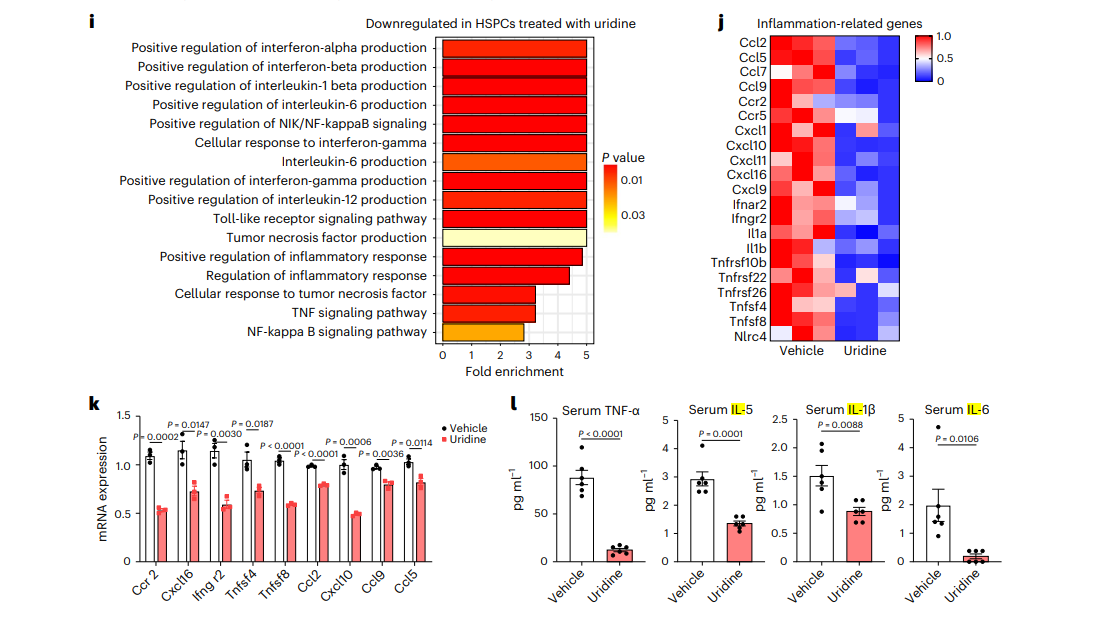A metabolic atlas of blood cells in young and aged mice identifies uridine as a metabolite to rejuvenate aged hematopoietic stem cells
造血干细胞老化, 自我更新能力受损, 髓系偏向, 免疫缺陷, 恶性肿瘤易感性增加, 代谢产物, 代谢组学图谱, 嘌呤代谢, 嘧啶代谢, 视黄醇代谢, 谷氨酸代谢, 鞘脂代谢, 尿苷, FoxO信号通路,Aging of hematopoietic stem cells, impaired self-renewal ability, myeloid skewing, immunodeficiencies, increased susceptibility to malignancies, metabolites, metabolomic profiles, different ages, mice, purine metabolism, pyrimidine metabolism, retinol metabolism, glutamate metabolism, sphingolipid metabolism, uridine, regulator, FoxO signaling pathway LabEX支持文献- Nat Aging.
- 2024
- 17
- Mouse
- Luminex
- serum
- 免疫/内分泌
- 衰老
- G-CSF,GM-CSF,GRO/KC,IFN-γ,IL-1α,IL-1β,IL-2,IL-4,IL-5,IL-6,IL-7,IL-10,IL-12 (p70),IL-13,IL-17A,IL-18,M-CSF,MCP-1,MIP-1α,MIP-3α,RANTES,TNF-α,VEGF
相关货号
Abstract
Aging of hematopoietic stem cells (HSCs) is accompanied by impaired self-renewal ability, myeloid skewing, immunodeficiencies and increased susceptibility to malignancies. Although previous studies highlighted the pivotal roles of individual metabolites in hematopoiesis, comprehensive and high-resolution metabolomic profiles of different hematopoietic cells across ages are still lacking. In this study, we created a metabolome atlas of different blood cells across ages in mice. We reveal here that purine, pyrimidine and retinol metabolism are enriched in young hematopoietic stem and progenitor cells (HSPCs), whereas glutamate and sphingolipid metabolism are concentrated in aged HSPCs. Through metabolic screening, we identified uridine as a potential regulator to rejuvenate aged HSPCs. Mechanistically, uridine treatment upregulates the FoxO signaling pathway and enhances self-renewal while suppressing inflammation in aged HSCs. Finally, we constructed an open-source platform for public easy access and metabolomic analysis in blood cells. Collectively, we provide a resource for metabolic studies in hematopoiesis that can contribute to future anti-aging metabolite screening.
LabEx Luminex平台助力建立小鼠不同年龄血细胞的代谢组图谱
本周为大家带来的文献为发表Nat Aging. (IF: 17.0)的” A metabolic atlas of blood cells in young and aged mice identifies uridine as a metabolite to rejuvenate aged hematopoietic stem cells”。本文使用了LabEx提供的Luminex检测服务。
造血是一个受严格调控且动态的过程,通过该过程,造血干细胞(HSCs)增殖并确保所有造血谱系的成熟血细胞的持续供应。血细胞的异质性和层次结构决定了它们复杂的生物功能,例如氧气运输、止血、免疫功能和营养运输。在衰老过程中,造血系统的功能逐渐下降,并伴随着血液恶性肿瘤风险的增加。
造血干细胞(HSCs)的衰老伴随着自我更新能力受损、髓系偏移、免疫缺陷和对恶性肿瘤的易感性增加。尽管先前的研究强调了个体代谢物在造血中的关键作用,但不同年龄的造血细胞的全面高分辨率代谢组学谱仍然缺乏。在这项研究中,研究者创建了小鼠不同年龄血细胞的代谢组图谱。
LabEx提供的Luminex检测服务
将老年小鼠随机分配为接受60天饮用水中添加尿苷(Absin,42157254)或常规饮用水。随后,收集血清并使用Bio-Rad的多重微球分析(LXLBM23-1,Labex Biotech)测量细胞因子的水平,同时收集HSCs以评估其克隆形成能力和移植能力。
在老龄小鼠中,口服尿苷还能降低血清中的全身炎症水平(TNF-α、IL-1β、IL-6 和 IL-5)(图 7l)。

接受药物或尿苷治疗的老龄小鼠血清中 TNF-α、IL-1β、IL-6 和 IL-5 的浓度(n = 每组 6 只小鼠,雌性,18-20 个月 C57BL/6J)
重要发现,
研究者发现,嘌呤、嘧啶和视黄醇代谢在年轻的造血干细胞和祖细胞(HSPCs)中富集,而谷氨酸和鞘脂代谢则集中在年老的HSPCs中。通过代谢筛选,确定尿苷作为一种潜在的调节剂可以使年老的HSPCs恢复活力。机制上,尿苷治疗通过上调FoxO信号通路增强自我更新能力,同时抑制年老HSCs的炎症。最后,研究者构建了一个开放源平台,便于公众对血细胞进行代谢组学分析。总体而言,本文提供了一个关于造血的代谢研究资源,可以为未来的抗衰老代谢物筛选做出贡献。
本网站销售的所有产品及服务均不得用于人类或动物之临床诊断或治疗,仅可用于工业或者科研等非医疗目的。







 沪公网安备31011502400759号
沪公网安备31011502400759号
 营业执照(三证合一)
营业执照(三证合一)


